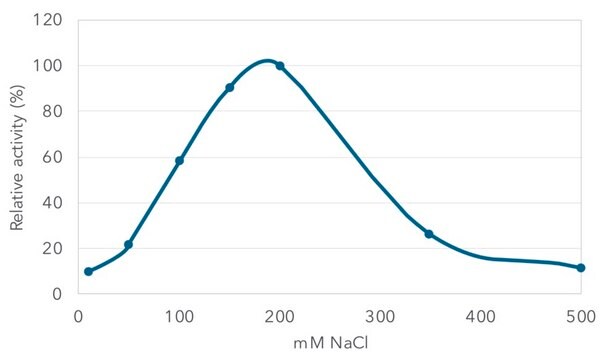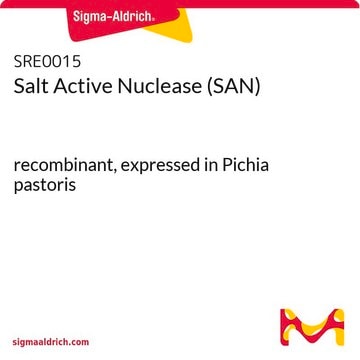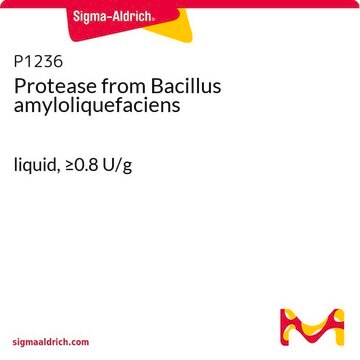추천 제품
일반 설명
Nucleic acids, and especially genomic DNA, often pose a problem in purification of DNA-binding proteins as they interfere with purification, downstream analysis or applications. As most nucleases are inhibited by high concentrations of salt, removal of DNA is difficult, since NaCl is used to dissociate DNA from proteins.
This Salt Active Nuclease (SAN) is a nonspecific endonuclease recombinantly produced in Pichia pastoris, with optimum activity at high salt concentrations. It is active in a variety of buffers and can be easily inactivated by treatment with a reducing agent. These features make it particularly useful in the purification of proteins and removal of DNA and RNA from molecular biology reagents. It can be used on cell lysates for viscosity removal, and additionally at the elution step of purification, where there are smaller volumes and a purer protein - allowing for effective and efficient DNA removal.
This Salt Active Nuclease (SAN) is a nonspecific endonuclease recombinantly produced in Pichia pastoris, with optimum activity at high salt concentrations. It is active in a variety of buffers and can be easily inactivated by treatment with a reducing agent. These features make it particularly useful in the purification of proteins and removal of DNA and RNA from molecular biology reagents. It can be used on cell lysates for viscosity removal, and additionally at the elution step of purification, where there are smaller volumes and a purer protein - allowing for effective and efficient DNA removal.
This Salt Active Nuclease (SAN) is a heat-labile nuclease that has optimal activity at high salt concentrations and is useful during protein purification.
애플리케이션
The high salt tolerance and easy removal makes this SAN useful in protein purification schemes, especially in combination with IMAC (Immobilized metal affinity chromatography) media used for purification of poly-His-tagged proteins.
특징 및 장점
- Active at up to 1M NaCl
Tolerates imidazole and can be separated from most proteins by cation exchange or inactivated by reducing agents.
단위 정의
One Unit is defined as an increase in absorbance at 260 nm of 1 A in 30 minutes at 37°C, using 50 μg/ml calf thymus DNA (D1501, Sigma) in a buffer consisting of 25 mM Tris-HCl, pH 8.5 (25°C), 5 mM MgCl2, 500 mM NaCl.
재구성
In solution
기타 정보
Temp: 5 – 40°C, optimal: ~ 35°C
Salt concentration (NaCI / KCI): 150 - 900 mM, optimal: 400 - 650 mM
Mg2+: >1 mM is required for activity, optimal: 5 - 50 mM
pH: 7.3 – 10, optimal: 8.2 - 9.2
Not recommended to use in presence of SDS or urea.
Salt concentration (NaCI / KCI): 150 - 900 mM, optimal: 400 - 650 mM
Mg2+: >1 mM is required for activity, optimal: 5 - 50 mM
pH: 7.3 – 10, optimal: 8.2 - 9.2
Not recommended to use in presence of SDS or urea.
Storage Class Code
10 - Combustible liquids
WGK
WGK 2
Flash Point (°F)
Not applicable
Flash Point (°C)
Not applicable
시험 성적서(COA)
제품의 로트/배치 번호를 입력하여 시험 성적서(COA)을 검색하십시오. 로트 및 배치 번호는 제품 라벨에 있는 ‘로트’ 또는 ‘배치’라는 용어 뒤에서 찾을 수 있습니다.
자사의 과학자팀은 생명 과학, 재료 과학, 화학 합성, 크로마토그래피, 분석 및 기타 많은 영역을 포함한 모든 과학 분야에 경험이 있습니다..
고객지원팀으로 연락바랍니다.








